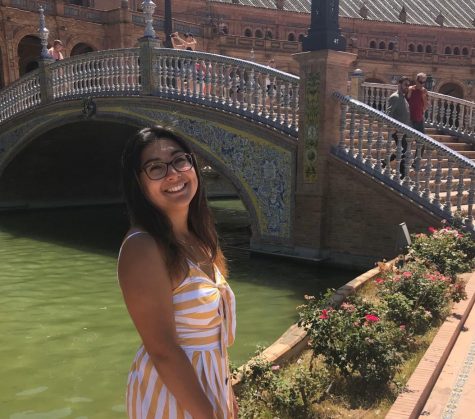Art as Activism: Shooting Without Bullets
Oct 17, 2019
On Nov. 24, 2014, Officer Timothy Loehmann shot and killed 12-year-old Tamir Rice, who was playing with an Airsoft gun in a Cleveland park. After receiving a 911 call about an African American boy waving around a gun, police arrived on the scene and fatally shot Rice within seconds, as explained in an article from Cleveland.com.
Tamir Rice is one of the many victims of state-sanctioned violence, which disproportionately affects people of color in the U.S. A Washington Post article reported that “black males accounted for 22 percent of all people shot and killed [by police] in 2017, yet they are six percent of the total population.”
As evidenced by the shooting of Tamir Rice, the nationwide racial disparity surrounding state-sanctioned violence has manifested itself in the city of Cleveland, inspiring activist Amanda King to create a non-profit, for-impact organization called Shooting Without Bullets in 2016. This organization uses art as a tool for activism to shift policy, perspective and culture that impacts the lives of black and brown youth in Cleveland.
Co-leaders King, S w/o B’s founder and creative director, and Kelsi Carter, its impact director, visited John Carroll University on Thursday, Oct. 10, to discuss their activist work in various theology classes. That evening, King and Carter, joined by several members of the youth artists collective, screened their documentary, “Underexposed,” followed by an art exhibition in Grasselli Library. It was a collaborative event put on by JCU’s Center for Student Diversity, Grasselli Library and the departments of Sociology and Criminology, Theology, and Peace, Justice and Human Rights.
In theology professor Krista Stevens’ class, King and Carter discussed their focus on giving black and brown youth the opportunity to impact public policy, as young people are most often affected by state-sanctioned violence, yet most often ignored, according to research by Anthony Bui of the University of California and colleagues, published in 2018. King determined that the creative process was the best way to give these young people a voice.
She commented on the power of visual images: “It is the visuals that compel people to really see and understand the perspective of our young people. You can talk about statistics all day, you can give definitions and you can read theory, like in your classes, but really, there’s something about an image that arrests you, that stops you, that sometimes is familiar to you or foreign to you, that makes you feel comfortable, that shocks you.”
As a result, S w/o B provides programming for youth ages 13-17 to teach them art skills in various disciplines, such as photography, music, performance and design, and how to use those skills as tools to comment on unjust systems of power present in the Cleveland area.
King then presented numerous photos taken by her artists, reflecting how “it is more difficult to be black than white in Cleveland,” pulling language from a 2018 News 5 Cleveland story that explored research from the Cleveland-based Center for Community Solutions.
These artists’ photographs touched on several issues that affect the African American community, specifically redlining (a federal government system that denied mortgage loans to people in low-income areas), racial inequality, poverty, state-sanctioned violence and gun violence.
In addition, King and Carter played a song called “Wake Up,” created by Aphiniti and J.B., two S w/o B artists who were inspired by the late Malcolm X’s “The Ballot or The Bullet” speech from 1964.
Carter elaborated, “The state of things, the racial inequity in Cleveland and the poverty in Cleveland, it is dismal. And I do believe that we should all be shocked into advocacy.”
While acknowledging the gravity of the situation, King managed to highlight the joy of activism by showing a photograph of a man protesting gun violence with a big smile on his face.
“Even though it was a really sad moment, this guy’s smile, I don’t know, it just moves me,” she said. “I think that it’s very reflective of how arts and culture can be a practice of joy for black and brown folks, and that even fighting for our rights can be something that brings us great joy because it’s the thing that keeps us and helps us to survive.”
While S w/o B artists are using their work to fight for social justice in their communities, they are also fighting for their right to be artists.
Carter and King said they realized that offering black and brown young people education was simply not enough.
“In the creative economy overall, in the arts ecosystem, there are immense barriers for black and brown people and immense barriers for folks who have come from low-income backgrounds in particular. The arts is looked at as this sort of wealthy, elite profession,” Carter explained.
To respond to these barriers, S w/o B also runs an artist collective for youth aged 18-21 who are pursuing their careers in the arts. King and Carter act as facilitators to ensure that their artists have opportunities to showcase their talents through performances, exhibitions and so on.
In the evening event on Oct. 10, King and Carter brought a panel of six artists from the collective to JCU to answer questions about their work with S w/o B. One of them, 19-year-old rapper Los P, spoke to the importance of these opportunities for black and brown youth.
“Gun violence in communities will not stop unless the youth have these opportunities,” Los P explained in response to a question about the most effective methods of combating gun violence. “The only thing that kept me out of trouble was riding bikes, and that was an opportunity given to me from my grandma. Another opportunity was at 15 or 16, I went to a photoshoot and then met Amanda.”
Katy Zoller ‘23 was struck by this topic: “One thing in particular to me that is very important is gun violence prevention, so hearing their opinions and viewpoints and tips about how to help this issue, the epidemic in the country, was very valuable, and I hope to incorporate them moving forward.”
These artists’ experiences were further highlighted during the screening of “Underexposed,” a short documentary created by the artists of S w/o B in 2017 to bring visibility to their communities and to illustrate their processes of self-discovery amidst vast racial and economic disparities.
After rewatching the documentary for the first time in almost two years, 19-year-old rapper, writer and poet J.B. said he was shocked by his own growth and the growth of his peers.
“This [film] was the start of me realizing how powerful each of us are, specifically myself,” J.B. said. “If it wasn’t for this, I wouldn’t have noticed how capable I was at anything that I am trying to achieve right now.”
Joe Veronica ‘23 was inspired by these artists’ stories and reflected on how he can learn from their activism. “It kinda made me question myself, but in a good way. How could I be more like them?” Veronica explained. “I want to enjoy what I do the way they do. I want to inspire others the way they do.”
The passion of the youth artists and their ability to inspire others present a couple of reasons why King and Carter strive to provide them with opportunities and exposure. Carter explained that the creative economy in Cleveland generates $9.1 billion annually and supports over 62,000 jobs, leaving no excuse for the racial and economic inequities within the art industry.
“This is not a poor city, it’s an unequal city,” Carter commented.
Returning to the image of the smiling protester, she continued, “We believe the arts to be something that is and should be accessible for anyone. … Art is a great equalizer. We’re looking at it through the same eyes, and we can come to these conversations from a different perspective and do so with joy.”
The youth collective’s art exhibition will be displayed at the Grasselli Library until Nov. 1. The pieces are available for sale on a sliding scale, using a “give what you can” system, and the proceeds go directly to the young artists.












